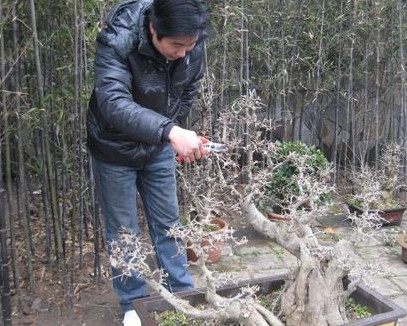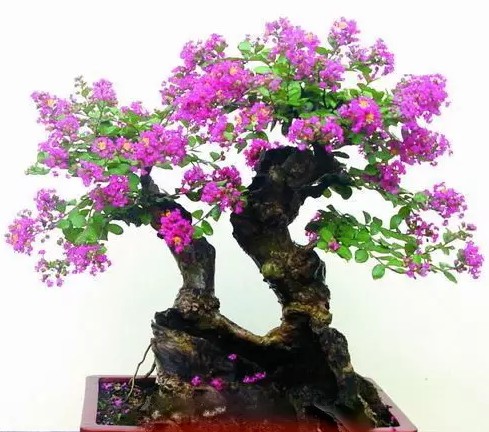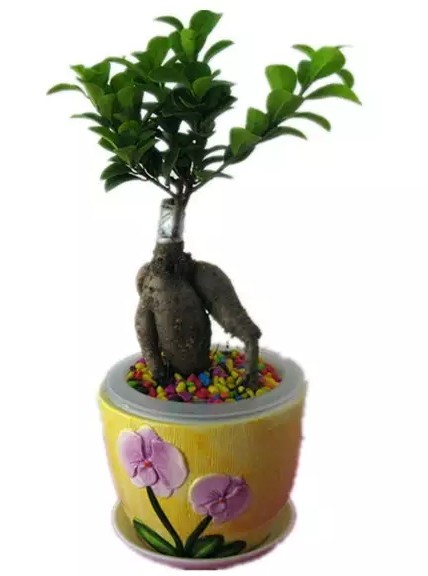How to achieve coordination in the process of tree bonsai modeling
In the creation of bonsai trees, each part of a bonsai which can be called a masterpiece must be integrated, unified and coordinated. Otherwise, it is not a good work. In the modeling, the various ornamental parts of bonsai, including stem, branch, leaf, flower, fruit and root, should unify each other and develop harmoniously. That is, its shape, volume, color, lines, form, style and so on, require a certain degree of identity, similarity or consistency, giving people a unified and coordinated feeling. A successful bonsai modeling work must form a high degree of unity of complex changes. Only in this way can we form a "harmonious" artistic whole. The sense of unity in bonsai modeling should strive to: the unity of artistic conception, the unity of form, the unity of materials, the unity of techniques, the unity of lines, the unity of part and whole. Only in this way can we achieve unity and coordination. Therefore, in modeling, we should pay attention to:

(1) coordination of style and posture
In order to achieve style and posture coordination, special attention should be paid to the following aspects in styling:
(1) focus on the theme, highlight the artistic conception and style coordination. The shape of the trunk, branch, crown and root of the tree must be coordinated.
This kind of coordination must have a unified standard, and this standard is the theme, that is, artistic conception. For example, if you want to show the image of ancient, old, sick and disabled, and show its tenacious vitality after the vicissitudes of life and ancient wild interest, you can make rotten (dry) bonsai. The trunk should show that the bark is peeled off and the xylem is exposed in many places, with grooves, grooves, holes and holes formed by xylem decay, as well as various bumps and scars. The epidermis of branches is old and tortuous. The whole branch and crown are relatively light and simple to adapt to the old. The root is exposed with muscles and bones, with the old spirit of the pan dragon root or radial pan dragon root to match. In this way, the overall modeling with tacit understanding, coordination. To make the subject image distinct and prominent is one of the keys to the success or failure of the works.
(2) the posture of branch, crown, root and trunk is coordinated. Based on the backbone, all parts cooperate and coordinate. The work should be based on the trunk style, and other parts should obey the trunk and serve the backbone. Only by making the backbone run through the overall situation can we achieve complete coordination and highlight the overall effect in one fell swoop.
For example, the trunk is straight, with a straight and majestic artistic connotation. Therefore, all the elements should be modeled and combined around this feature. Such as the use of vigorous antler branches or chicken claw branches, steel claw-like radial roots, and the use of rising fan-shaped crown with the trunk, it appears that the whole tree is coordinated.
Another example is qu dry bonsai, if the trunk modeling adopts the modeling techniques of "storing branches and cutting dry" and "replacing dry with side", the trunk is tortuous and well-organized. Therefore, "just" is its main feature. Then its side branches should also use strong and powerful "zigzag branches" to coordinate with the trunk. However, bending branches dominated by softness must not be adopted to prevent the basic principle of coordinated development from being undermined (see figure 4mur1).
(3) coordination between main tree and planting tree, tree and accessories, individual and group posture. Double-dry five-needle pine bonsai with the same extension direction is certainly coordinated, but the double-dry, two-trunk and one-oblique layout of miscellaneous wood is also a natural coordination (see figure 4mur2). In the jungle bonsai, the trunk is straight-type jungle bonsai, while the miscellaneous trees take the straight trunk of the main tree as the center, and the other trunks tilt to the outside to form a radial layout, which also belongs to coordination.
In the cluster-type bonsai, the selection of trees should be big and small, tall and short, straight, oblique and curved. In this way, through the combination to achieve high and low coordination, size coordination, straight oblique coordination, density coordination, hidden coordination. To achieve the harmony and coordination of the main tree and planting trees, unified style and natural posture. On the other hand, the layout of more than four bushy plants is also coordinated when they are divided into two or three groups for plane layout.
In addition, when decorating accessories in bonsai modeling, the shape of accessories must be unified and coordinated with the expression intention of the main trees to make them serve the main body. Do not rob the guests and destroy the overall image design.
(4) the style of view, basin and frame is coordinated. Bonsai modeling production of the selection of the basin and shelf, must take the scene as the center, the basin and the frame closely cooperate with it, play the role of rendering, it and the scene must cooperate with tacit understanding, the style is consistent. For example, the flat and long basin is suitable for setting off the straight dry type, oblique dry type, double dry type, jungle type and other bonsai, while the high basin is only suitable for the cliff type bonsai, while the curved dry type bonsai is sometimes more appropriate with the arc-shaped medium-high basin. The straight dry type and the long and flat basin make a horizontal and vertical, a moving (tree) and a static (basin) contrast to each other, full of harmonious and beautiful charm. If it cooperates with medium and high basins, there will be a lack of horizontal and vertical configuration, and the trend of being tall and straight will be seriously weakened (see figure 4mur3). For the selection of several aircraft, the "same shape and matching" is the most coordinated and unified. Such as round basin with round several, square basin formula several, Gao Weng with viaduct, consistent shape and easy style coordination.
(2) proportional coordination
Proportion is an important factor in the aesthetic appreciation of bonsai trees, which is explained by the so-called "shrinking dragon into an inch". The same specification of tree species, shape, if the proportion is not coordinated, it will greatly weaken its artistic effect. Proportion runs through the whole process of bonsai modeling, including the ratio of size, height, thickness, length and so on. The list is as follows:
(1) the proportion of the backbone is coordinated. It mainly includes the proportion coordination of each part of the trunk itself, as well as the proportion coordination between the trunk and the trunk. If the trunk itself should be thick to thin, the transition is natural. The bending position of the trunk becomes shorter from the bottom up. When double trunk and more than double trunk, the trunk of main tree should be thick and high, while the planted tree is relatively short and small. The jungle bonsai should be big in front and small in the back. That is, the short-range should be large and the long-term perspective should be small. In the double-trunk type, the ratio of tree height and branch width to the main tree is 0.5 / 0.8. The crown volume of the main tree should be larger than that of the planted tree.
(2) the proportion of branches and receptacles is coordinated.
The distance between ① branches and receptacles is longer than that of other branches.
The length of the lateral branch of ② is generally long at the bottom and short at the top, and the supporting position of the main branch should be born in the first receptacle of the lower part.
The thickness of ③ branch receptacle is thicker than thinner.
(3) the ratio of branch to stem is coordinated.
The main results are as follows: (1) the height of the first branch is in harmony with the height of the whole tree, and the height of the first branch should be more than 1/3 of the height of the tree.
The thickness of the first receptacle of ② should be about 1/3 of that of the trunk. The more upward, the closer the ratio of branch to stem thickness is.
(4) the proportion of the size of the basin, frame and scene is coordinated. Although the proportion of different bonsai styling forms and pots is different. But visually speaking, trees look small and powerless if they are too poor. On the contrary, if the tree is big and the basin is small, it appears top-heavy and unstable. In general, when using long and flat pots, the length of the basin is about 2/3 of the branch width of the whole tree (see figure 4). The size of several planes should depend on the basin, the basin is long, the basin is short, and the basin is short (see figure 4, Mel 5).
(5) the proportion of accessories is coordinated. It includes not only the proportion coordination of accessories and trees, but also the proportion coordination of accessories and accessories. There is a saying in the painting theory: "Zhangshan foot tree, inch horse divides people". Bonsai should also pay attention to the proportional relationship, accessories are too large, will make the original mood of tall trees become relatively young. At the same time, accessories should also grasp the perspective principle of the big and the small.
(3) Color coordination
For the color coordination of bonsai modeling, we should mainly pay attention to the following aspects:
(1) the colors of different trees are coordinated. In double-dry, three-trunk or jungle bonsai, the same tree species are generally used. In this way, different trees are not only similar in posture, but also in harmony in color. If different color tree species are used in the jungle style, there must be subjects and followers, and the object trees only play the effect of embellishment and coordination, and the color coordination must not be destroyed.
(2) the potted color is in harmony with the tree landscape. When choosing a pot scion, the choice of color must be coordinated with the trees. Old trunk, bark peeling generally use deep and simple basin color. Light and clean bonsai should be chosen for those with light leaves and light color and delicate posture. In the bonsai of viewing flowers and fruits, those with dark flowers and fruits should choose light-colored pots, while those with light colors should choose dark pots.
(3) the color of accessories should be in harmony with the scene and basin, but the color of the gadget should be different from the color of the basin. In short, it should not be too messy and dazzling.
Time: 2019-06-13 Click:
- Prev

Cuttage Propagation technique of crape myrtle Bonsai
Crape myrtle is graceful, with curved branches and bright colors. It is a small deciduous tree of the family Euphorbiaceae. Crape myrtle blossoms for a hundred days, gently caressing the branches and stems of the whole tree. Therefore, crape myrtle is also known as a hundred-day red, itchy tree. Planting crape myrtle should choose the leeward and sunny place with deep soil, fertile soil and good drainage. Big seedlings should be transplanted with soil balls.
- Next

Tree shape making and pruning method of ginseng banyan bonsai
Ginseng banyan bonsai modeling, the main effort should be used to lift the root, so that it forms the shape of hanging roots and showing claws. Of course, branches, stems and leaves can not be ignored, because they are an inseparable whole of a tree. The branches and leaves are often modeled in a hierarchical natural style. The branches of the banyan tree are soft, and the banding time is longer than the average tree.
Related
- Fuxing push coffee new agricultural production and marketing class: lack of small-scale processing plants
- Jujube rice field leisure farm deep ploughing Yilan for five years to create a space for organic food and play
- Nongyu Farm-A trial of organic papaya for brave women with advanced technology
- Four points for attention in the prevention and control of diseases and insect pests of edible fungi
- How to add nutrient solution to Edible Fungi
- Is there any good way to control edible fungus mites?
- Open Inoculation Technology of Edible Fungi
- Is there any clever way to use fertilizer for edible fungus in winter?
- What agents are used to kill the pathogens of edible fungi in the mushroom shed?
- Rapid drying of Edible Fungi

